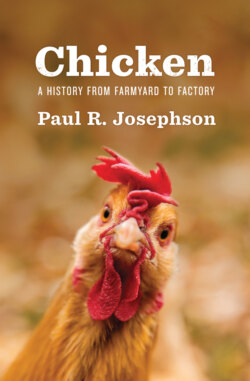Читать книгу Chicken - Paul R. Josephson - Страница 11
From Cage to Carcass
ОглавлениеThis book aims at a fuller understanding of the chicken raised in factory farms, perhaps as a Neo-Luddite might write it, hoping to promote realization about how industrial forces and capitalism changed what was a domesticated yard bird into a protein machine. If this can lead to greater regulation of the industry in the name of animal welfare, pollution control, public health and safety, then I will have succeeded in some small way in meeting my goal. But, above all else, this is a political and environmental history of the broiler, from its early domestication as a chicken, to a provider of the occasional egg or a one-time tough and sinewy meal, or as a meaningful religious symbol; to its appearance as a friend of the family, the farmer and as a collector’s item – Queen Victoria of England being among their admirers; to the factory farm. And it is a history of the chicken that has been transformed by humans from an active, social bird with an ecology of running, pecking and establishing a social (pecking) order that required sun, air, greens and exercise, to one entirely confined to a vanishingly small space, and intended to be chowed down after assembly-line execution before even reaching full maturity.
Through hybridization, and eventually through genetics, capitalism was joined with research and agriculture to build broiler birds with specific growth, fat, meat, enzyme, flavor and other properties. By 2000, just three firms in the world provided the vast majority of these magnificent meat machines through their breeder banks. According to the United Nations Food and Agriculture Organization (FAO), there has been a marked decline in the past half-century of farm livestock breeds, in large part because of this process. “Up to 30% of global mammalian and avian livestock breeds (i.e., 1,200 to 1,500 breeds) are currently at risk of being lost and cannot be replaced.”49 A Purdue University study in the Proceedings of the National Academy of Sciences reported that 50 percent or more of ancestral chicken breeds have been lost, and that the greatest decline in chicken diversity took place in the 1950s with the introduction of industrial chicken production.50
In the late 1940s, encouraged by the Great Atlantic and Pacific Tea Company (A&P Supermarkets), thousands of farmers took part in “Chicken of Tomorrow” to present the best, meatiest breeds, which A&P intended to use in display cases around the nation to build America’s taste for chicken. These breeds have given way to the technologically superior broiler (meat generator) of factory farms: a faster-growing chicken with more meat on its bones. The birds are strong in meat, but, like any monoculture, prone to disease, foodborne and otherwise, and with skeletal, vision and other weaknesses. In many ways, they are an icon of CAFOs: meatier, but sicker, birds requiring more and more energy inputs, including antibiotics. They are chickens with an industrial essence. It is time for a new contest – a contest not for a new Chicken of Tomorrow, but rather for a new kind of agriculture, one that is less focused on corporate profits and more focused on producing strong healthy farms and food, that strengthens farm communities and supports local as well as distant markets.
